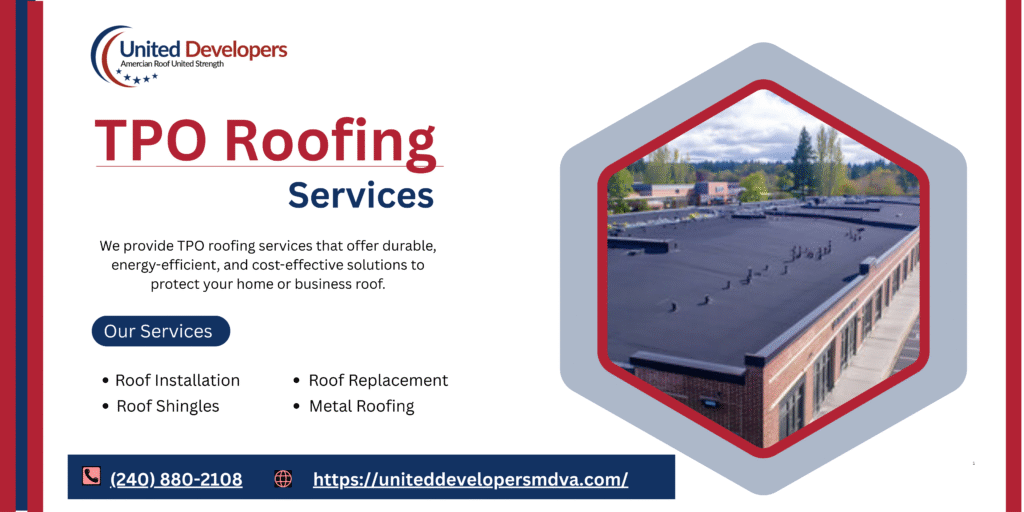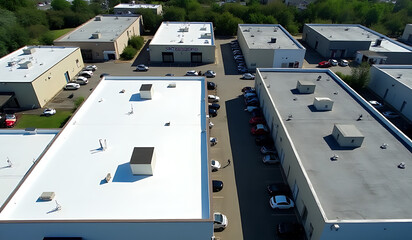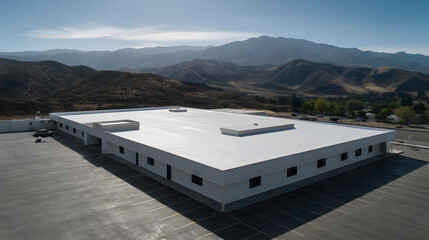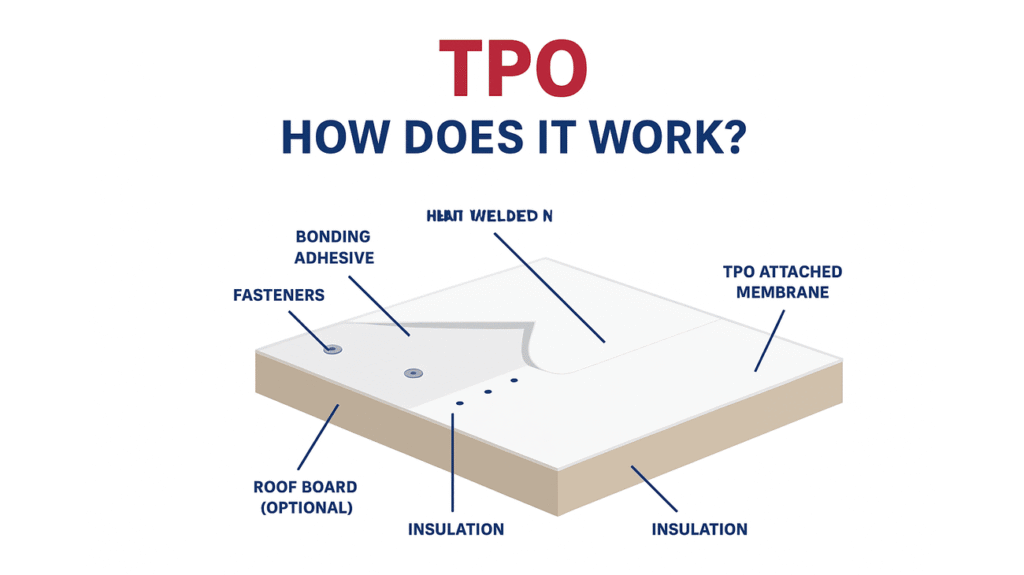TPO roofing is a single-ply membrane used mostly for flat and low-slope roofs. It is lightweight, strong, and reflects sunlight, helping buildings stay cool while saving on energy costs.
In 2026, TPO roofing is a smart choice because it is affordable, eco-friendly, and long-lasting. Homeowners and businesses choose it for durability, low maintenance, and energy efficiency.

Table of Contents
1. Understanding TPO Roofing
What is TPO roofing?
TPO stands for Thermoplastic Polyolefin, a single-ply roofing membrane made of ethylene-propylene rubber and thermoplastics, reinforced with polyester scrim. It is manufactured in layers that provide flexibility, UV resistance, and strength against wear and tear.
This roofing membrane is available in different thicknesses such as 45-mil, 60-mil, and 80-mil, with white being the most common color because of its reflective, energy-saving benefits.
2. Why Choose TPO Roofing in 2026?
Energy Efficiency & Sustainability
- Reflective properties: TPO’s white surface reflects up to 80% of sunlight, keeping buildings cooler.
- Cost savings: Reduces energy bills by lowering air conditioning needs.
- Eco-friendly: Chlorine-free and 100% recyclable, making it a green choice for modern construction.
Durability & Installation
- Heat-welded seams: Seams are 3-4 times stronger than traditional adhesive seams, minimizing leaks.
- Resistant material: Withstands UV rays, ozone, chemicals, and punctures.
- Flexible installation: Available in large rolls, which reduce labor time and costs.
Cost-Effectiveness
- Lower initial costs compared to many alternatives.
- Long lifespan of 15–30 years with minimal maintenance.
- Excellent return on investment due to energy savings and durability.
3. Comparing TPO with Other Roofing Types
| Feature / Material | TPO Roofing | EPDM Roofing | Modified Bitumen |
|---|---|---|---|
| Energy Efficiency | Very high (white reflective surface) | Low | Moderate |
| Durability | Strong seams, UV-resistant | Tear/puncture susceptible | Moderate |
| Ease of Installation | Easy with heat welding | Easy but uses tape/sealers | Labor-intensive |
| Eco-Friendliness | Recyclable and chlorine-free | Less eco-friendly | Depends on layers |
| Cost | Affordable long-term investment | Cheaper upfront | Mid-range |
TPO stands out as the best balance between cost, durability, and eco-friendly performance.
4. Challenges to Consider
While TPO is excellent, there are some factors to keep in mind:
- Seam failure risk: If not installed correctly, seams may weaken over time.
- Material differences: Quality can vary between manufacturers, so professional selection matters.
- Staining issues: Susceptible to oils and dirt, which can impact appearance.
- Requires skilled installation: Precision welding and handling are necessary for maximum performance.


5. The 2026 Advantage – Why Now?
In 2026, TPO roofing is better than ever:
- Stronger membranes: Modern technology has improved lifespan and resistance.
- Rising energy costs: Energy-efficient roofing saves more money now than ever.
- Eco regulations: More incentives and requirements for green building favor materials like TPO.
6. Real Success in Maryland
Customer: Vanessa, Silver Spring, MD
“United Developers did an amazing job on our roof. From start to finish, they were professional, responsive, and detail-oriented. Our building is cooler, more comfortable, and looks fantastic.”
Vanessa needed a reliable, long-lasting solution for her flat roof. United Developers MDVA recommended and installed a 60-mil TPO membrane. The results were impressive:
- Lower indoor cooling costs
- Cleaner, more modern appearance
- Seamless protection against leaks
Her project shows how TPO roofing can deliver lasting benefits for both comfort and cost savings.
7. Final Thoughts: United Developers MDVA – Your TPO Experts in 2026
- Licensed and insured professionals
- Skilled in advanced TPO installation methods
- Use of high-quality, durable roofing membranes
- Focus on sustainability and energy efficiency
- Proven record of satisfied customers across Maryland, Virginia, and beyond
How Does TPO Roof Work?

TPO roof works by using a single-ply membrane attached to insulation and roof boards with fasteners and bonding adhesive. The seams are heat-welded, creating a strong, watertight seal. This system makes TPO roof durable, energy-efficient, and resistant to leaks, making it a reliable choice for both homes and commercial buildings.
Ready to Upgrade?
If you’re looking for a roofing solution that is durable, eco-friendly, and cost-effective, TPO roof in 2026 is the smart choice. United Developers MDVA is here to help you protect your property and enjoy the long-term benefits of modern roofing technology.
FAQs – TPO Roof
1. What is TPO roofing?
TPO roofing is a single-ply roofing membrane made of polymer and rubber blends. It’s known for flexibility, heat-welded seams, and strong resistance to UV and weather damage. Learn more at uniteddevelopersmdva.com.
2. Why should I consider TPO roofing for my building in 2026?
Choosing TPO roofing in 2026 means investing in energy efficiency, eco-friendliness, and durability. Its reflective surface lowers cooling costs while providing a recyclable, long-lasting roofing option. Visit uniteddevelopersmdva.com for details.
3. How long does TPO roofing typically last?
With proper installation and care, TPO roofing can last 20 to 30 years, offering excellent long-term protection and value for property owners. See more at uniteddevelopersmdva.com.
4. Is TPO roofing cost-effective compared to other roofing materials?
Yes, TPO roofing is affordable upfront and saves money over time with lower energy bills, fewer repairs, and minimal maintenance needs. Explore options at uniteddevelopersmdva.com.
5. Can TPO roofing help reduce my energy bills?
Absolutely! The reflective design of TPO roofing reduces heat absorption, easing strain on HVAC systems and lowering cooling costs, especially in warmer areas. Learn more at uniteddevelopersmdva.com.
6. Is TPO roofing environmentally friendly?
Yes, TPO roofing is recyclable, free of harmful plasticizers, and helps reduce the heat island effect in urban environments, making it a sustainable option. Visit uniteddevelopersmdva.com for eco-friendly roofing solutions.
7. What distinguishes TPO from other single-ply roofing options like EPDM?
Unlike EPDM, TPO roofing has heat-welded seams that are three times stronger and provides superior UV resistance and energy efficiency. Get expert insights at uniteddevelopersmdva.com.
Contact US:
If you’re considering TPO roof for your home or business, our expert team at United Developers MDVA is here to help.
We provide professional guidance, quality installation, and reliable service to ensure your roof lasts for years. Contact us today to schedule a free consultation and discover why TPO roof is the right choice for 2026.


